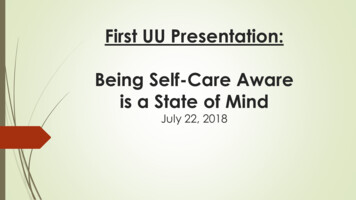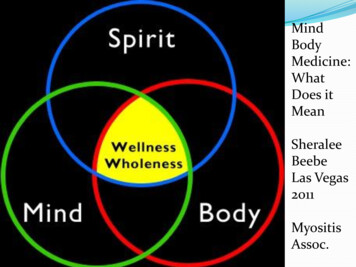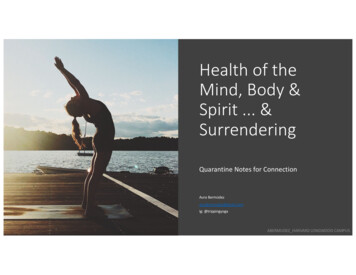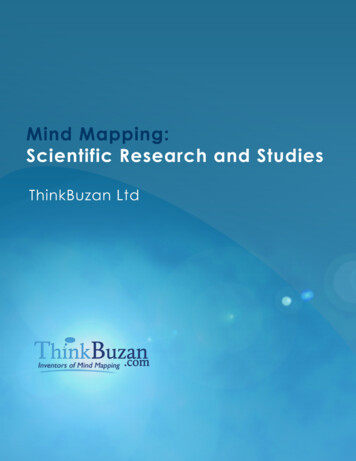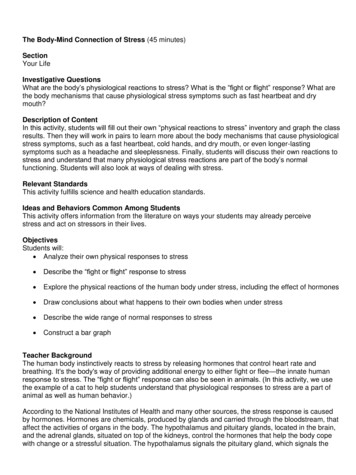
Transcription
The Body-Mind Connection of Stress (45 minutes)SectionYour LifeInvestigative QuestionsWhat are the body’s physiological reactions to stress? What is the “fight or flight” response? What arethe body mechanisms that cause physiological stress symptoms such as fast heartbeat and drymouth?Description of ContentIn this activity, students will fill out their own “physical reactions to stress” inventory and graph the classresults. Then they will work in pairs to learn more about the body mechanisms that cause physiologicalstress symptoms, such as a fast heartbeat, cold hands, and dry mouth, or even longer-lastingsymptoms such as a headache and sleeplessness. Finally, students will discuss their own reactions tostress and understand that many physiological stress reactions are part of the body’s normalfunctioning. Students will also look at ways of dealing with stress.Relevant StandardsThis activity fulfills science and health education standards.Ideas and Behaviors Common Among StudentsThis activity offers information from the literature on ways your students may already perceivestress and act on stressors in their lives.ObjectivesStudents will: Analyze their own physical responses to stress Describe the “fight or flight” response to stress Explore the physical reactions of the human body under stress, including the effect of hormones Draw conclusions about what happens to their own bodies when under stress Describe the wide range of normal responses to stress Construct a bar graphTeacher BackgroundThe human body instinctively reacts to stress by releasing hormones that control heart rate andbreathing. It's the body's way of providing additional energy to either fight or flee—the innate humanresponse to stress. The “fight or flight” response can also be seen in animals. (In this activity, we usethe example of a cat to help students understand that physiological responses to stress are a part ofanimal as well as human behavior.)According to the National Institutes of Health and many other sources, the stress response is causedby hormones. Hormones are chemicals, produced by glands and carried through the bloodstream, thataffect the activities of organs in the body. The hypothalamus and pituitary glands, located in the brain,and the adrenal glands, situated on top of the kidneys, control the hormones that help the body copewith change or a stressful situation. The hypothalamus signals the pituitary gland, which signals the
adrenal glands to release the stress hormones epinephrine, norepinephrine, and cortisol. Thesechemicals increase heart rate and breathing, which provides a burst of energy (to fight or flee), as wellas affect other bodily functions. The release of these hormones can result in a wide range of physicalreactions to stress, including headache, dry mouth, difficulty swallowing, rapid heartbeat, nausea, coldhands, lack of concentration, difficulty sleeping, certain food cravings, and angry outbursts.TMResearch to develop the BAM! Body and Mind Web site showed that kids and teens are veryconcerned about stress in their lives and interested in learning how to manage it. Parents areinterested in helping their kids manage stress as well.In this lesson we suggest using two segments of the BAM! Web site. The “Got Butterflies” game andthe “Feelin’ Frazzled?” 10 tips for relieving stress. You may want to review them first. If your studentsdo not have easy access to the Internet, you can still use this lesson.Materials Student Reproducible 1: Taking Stock: My Body’s Reaction to Stress Student Reproducible 2: Cold Hands, Fast Heart: The Body’s Physiological Reaction to StressSafetyNormal classroom safety procedures should be followed.ProcedureEngagement (10 minutes)1. Before learning about the body's chemical reactions to stress, students will complete aself-assessment of their own physiological reactions to stress. Pass out Student Reproducible 1:Taking Stock: My Body’s Reaction to Stress.2. Talk with students about the drawing of the cat and the information that is included on the top ofthe student reproducible. Ask them whether they have ever seen a cat respond to a stressfulsituation—a dog runs by, another cat wanders onto its territory, it’s time to go to the vet. What docats do in this situation? Let students discuss briefly.3. Point out that cats don’t have to think about how they will respond. The “fight or flight” responsejust happens. Ask students to discuss specific adaptations that other organisms posses thatallow them to respond to stressors in their environment. (For example, porcupines release theirquills. Dogs growl.) Think of other reactions students have seen in animals.4. Tell students that humans also have this response. The survival instinct ("fight or flight") ishardwired into their bodies.Exploration (15 minutes)1. Have students fill out the self-assessment. What are the physiological ways in which they reactto stress?2. Once they have completed the self-assessment, compile students’ reactions into a bar graph.You can do this as an in-class activity, or you could collect the data in class and assign the bargraph as homework. (One online tool for creating graphs can be found at the National Center forEducation Statistics’ Create a Graph Web ult.aspx
Here is an example of how a bar graph might look:Explanation (20 minutes)1. Hand out Student Reproducible 2: Cold Hands, Fast Heart: The Body's Physiological Reactionto Stress. Tell students they will now learn why they have these reactions.2. Explain that hormones produce the “fight or flight” responses in animals, including people.Hormones are chemicals, produced by glands and carried through the bloodstream, that affectthe activities of organs in the body.3. Have students read through Student Reproducible 2 and look at the anatomical drawing. Then,review with the class the glands and hormones that control the physiological reactions to stress.The hypothalamus and pituitary glands, located in the brain, and the adrenal glands, situated ontop of the kidneys, (see drawing on the reproducible) control the hormones that help the bodycope with change or a stressful situation. The hypothalamus signals the pituitary gland thatsignals the adrenal glands to release the stress hormones epinephrine, norepinephrine, andcortisol. These chemicals increase the heart rate and breathing, which provides a burst ofenergy (to fight or flee), as well as affects other bodily functions. [Note: Another hormone ismentioned in the explanation of the body under stress below: serotonin, which both increasesgood feelings and regulates sleep.]4. As you review how stress affects the body, ask the students to explain the underlyingphysiological reaction to a symptom of stress. Then correct, if necessary. The first six itemslisted below are common responses to short-term stress. The others, headaches,sleeplessness, appetite change, and unusual sudden anger are usually responses tolonger-term stress.
Guide for Discussing Student Reproducible 2 The cold hands you may experience when under stress are a result of the stress hormonesshooting through the bloodstream and moving blood away from the skin. While it gives theheart and muscles more strength, it can leave appendages feeling cold. Stress hormones send blood to vital organs like the heart, lungs, and liver. Less blood goesto the muscles. The throat, which is a muscle, may tighten and make it hard to swallow. Cortisol, one of the stress hormones, shuts down the stomach and won't let food digest,while at the same time putting the digestive tract into high gear. This can make you feelnauseated. Once the stress response is running full force, your body sends your blood to only thoseparts that are truly necessary for survival. With much of the fluid in your body going to yourorgans, your mouth may become very dry. Stress hormones speed up the flow of blood by 300-400 percent. The heart beats faster tomove all of that blood to organs and muscles, which is why you feel your heart pounding. Stress hormones affect your short-term memory so that you can focus on the “danger” athand. They also signal your brain to store the memory of the stressful event in your long-termmemory so you know how to respond the next time something stressful happens. One resultof these instinctive physiological responses is that it's hard to concentrate. Headaches are one of the common symptoms of long-term stress. Although experts are notclear on the causes, tight head and neck muscles are generally thought to be to blame. Also,the chemical messengers in your brain tell the blood vessels to constrict (get really small).This means that less blood gets to your head, which can cause a headache. In a normal, stress-free day, the levels of hormones that give you energy (epinephrine andnorepinephrine) stay consistent. At the end of the day, they naturally begin to decrease andthe hormone that helps you sleep (serotonin) kicks into high gear. But if you're under stressfor awhile, your body continues to produce epinephrine and norepinephrine, which block outthe serotonin, resulting in sleeplessness. Changes in appetite are a common response to stress. For some it's a craving, for others, it'sa loss of appetite. Certain foods increase the levels of serotonin (also a feel-good hormone),improving your mood. Many people crave foods under stress such as candy bards, soda, orice cream, but different people have different cravings. (Point out to students that eatinghealthy foods helps them have energy and guard against stress.) Stress can make you feel helpless and overwhelmed, which may result in triggering frequentangry outbursts. You just don't have the patience you normally would have.
5. Point out that for many people, understanding what’s happening in their bodies—what they’vejust learned—makes them less self-conscious about their own physiological reactions to stressand can even relieve those symptoms.6. Point out to students that their being stressed does not give them an excuse for being hurtful toothers or an excuse not to do what they should be doing in school or at home.7. If you are not planning to do another BAM! activity on stress, “Feeling Frazzled? Stress andWhat to Do About It,” you may want to copy and hand out “Feeling Frazzled?” tip sheet. Itincludes 10 suggestions for relieving stress.Elaboration and Evaluation (time will vary based on number of computers available)1. Have students go online and explore the “Got Butterflies?” feature. This feature reviews all theshort- and long-term physiological signs of stress and provides ideas for students on beatingstress. If your students do not have access to the Internet, you can print out the content and giveit to your students as homework.Performance DescriptorsOn each of the criteria below, rate students from 3 to 0, with 3 being the highest possible score and 0being the lowest.Scoring Rubric: The Body-Mind Connection of StressPerformance DescriptorStudent completed the self-assessment of his or her ownphysiological reactions to stress.Student described the “fight or flight” response to stress inanimals, including humans.Student used data collected in class about classmates’ reactions tostress to create a bar graph that shows the data.Student analyzed and drew conclusions about his or her ownindividual reactions to stress.Student explored the physical reactions of the human body understress, including the effect of hormones.Rating32103210321032103210Extension1. Some students may be interested in animal behavior. Have them do research and present to theclass information about other animals’ fight or flight response.2. Have students do research and present to the class information on all the glands of theendocrine system and whether or not they are involved in the stress response.Web ResourcesCenters for Disease Control and Prevention (CDC): www.cdc.govThe CDC Web site includes data on stress in various professions, including statistics on stresssuffered by first responders.
TMCDC BAM! Body and MindBAM! Body and Mind is brought to you by the Centers for Disease Control and Prevention(CDC), an agency of the U.S. Department of Health and Human Services (DHHS). BAM! wascreated to answer kids' questions on health issues and recommend ways to make their bodiesand minds healthier, stronger, and safer. BAM! also serves as an aid to teachers, providing themwith interactive activities to support their health and science curriculums that are educational andfun.eMedicine: natomy of the Endocrine System:http://www.emedicinehealth.com/anatomy of the endocrine system/article em.htmThis Web site is written by medical professionals, but geared toward a general audience. Itincludes an overview on the endocrine system as well as more detailed descriptions aboutmajor glands in the endocrine system.Kids Health: www.kidshealth.org Endocrine System:www.kidshealth.org/parent/general/body basics/endocrine prt.htmBasic information on the endocrine system, including descriptions of glands and the physicalactivities they regulate. Written for a general audience.Stress: www.kidshealth.org/teen/your mind/emotions/stress.htmlBasic information on stress, including information about the endocrine system. Written for ateenage audience.American Academy of Child and Adolescent Psychiatry: www.aacap.orgHelping Teenagers with Stress:http://aacap.org/page.ww?name Helping Teenagers with Stress§ion Facts for FamiliesA fact sheet, written for a general audience, on things families can do to help teens reducethe level of stress in their lives.National Institutes of Health: www.nih.govText CorrelationsCentre Point Learning, Science II: Essential Interactions, Unit 1: Cells, Tissues, Organs, and SystemsGlencoe, Science Voyages, Level Green, Chapter 22, The Endocrine SystemGlencoe, Teen Health Course 1, Chapter 1, Mental and Emotional Health: Managing StressGlencoe, Teen Health Course 2, Chapter 7, Mental and Emotional Health: Managing StressGlencoe, Teen Health Course 3, Chapter 15, Your Body Systems: Your Endocrine System
Relevant StandardsNational Science Education StandardsContent Standard F, Grades 5-8As a result of their activities in grades 5-8, all students should develop understanding of Structure and function in living systemsReproduction and heredityRegulation and behaviorPopulations and ecosystemsDiversity and adaptations of organismsRegulation and Behavior All organisms must be able to obtain and use resources, grow, reproduce, and maintain stableinternal conditions while living in a constantly changing external environment.Regulation of an organism's internal environment involves sensing the internal environment andchanging physiological activities to keep conditions within the range required to survive.Behavior is one kind of response an organism can make to an internal or environmentalstimulus. A behavioral response requires coordination and communication at many levels,including cells, organ systems, and whole organisms. Behavioral response is a set of actionsdetermined in part by heredity and in part from experience.An organism's behavior evolves through adaptation to its environment. How a species moves,obtains food, reproduces, and responds to danger are based in the species' evolutionary history.Benchmarks for Science LiteracyChapter 6, Benchmark C, Grades 6-8: Basic FunctionsNerves and hormones carry messages that contract muscles to help the organism respond to itsenvironment.By the end of the 8th grade, students should know that: Hormones are chemicals from glands that affect other body parts. They are involved in helpingthe body respond to danger and in regulating human growth, development, and reproduction. Interactions among the senses, nerves, and brain make possible the learning that enableshuman beings to cope with changes in their environment.Chapter 12, Benchmark D, Grades 6-8: Communication SkillsBy the end of the 8th grade, students should be able to: Organize information in simple tables and graphs and identify relationships they reveal.Read simple tables and graphs produced by others and describe in words what they show.Locate information in reference books, back issues of newspapers and magazines, compact
disks, and computer databases.Understand writing that incorporates circle charts, bar and line graphs, two-way data tables,diagrams, and symbols.National Health Education StandardsStandard 1 Students will comprehend concepts related to health promotion and disease prevention. Explain the relationship between positive health behaviors and the prevention of injury, illness,disease, and premature death.Describe the interrelationship of mental, emotional, social, and physical health duringadolescence.Explain how health is influenced by the interaction of body systems.Describe how family and peers influence the health of adolescents.Analyze how environment and personal health are interrelated.Describe ways to reduce risks related to adolescent health problems.Standard 3Students will demonstrate the ability to practice health-enhancing behaviors and reduce health risks. Analyze a personal health assessment to determine health strengths and risks.Distinguish between safe and risky or harmful behaviors in relationships.Demonstrate strategies to improve or maintain personal and family health.Demonstrate ways to avoid and reduce threatening situations.Demonstrate strategies to manage stress.Ideas and Behaviors Common Among StudentsWhat Stress Is When asked what stress means to them, middle school students responded that stress wascharacterized as “being under a lot of pressure,” “feeling angry or annoyed,” “too much on yourmind and you can’t take it anymore,” and “pressure and more stomach problems” (D’Autuono,1998). In general, children have identified the majority of the stressful events in their lives as stemmingfrom school-related problems (i.e., tests, grades, assignments.) Other stressful areas in theirlives were associated with peer relationship problems as well as home and family problems(Henderson & Kelbey, 1992). Middle school girls appear more likely to rate traumatic events as more stressful than boys,while those from socially disadvantaged areas rate everyday events as more stressful thanchildren from more affluent backgrounds (Muldoon, 2003).Effects of Stressthth When describing stressful situations, 4 to 6 grade students were most likely to say that theyfelt headache and stomachache as their main physiological symptoms. Boys were also likely tosay they felt their “heart beating fast,” while girls said that they felt “sweaty” (Sharrer &Ryan-Wenger, 2002). Middle school students also reported that stress made them feel “sad and lonely,”“uncomfortable and nervous everywhere I go,” “like it’s never going to end,” and “tense”
(D’Autuono, 1998). When middle school students were asked specifically about school-related stress, this type ofstress was associated with lack of concentration, trouble remembering, and frustration (Mailandt,1998). When describing their reactions to general stressful situations, boys were most likely to say thatthey felt mad, worried, or nervous, while girls would cry or feel sad, as well as feel mad andworried (Sharrer & Ryan-Wenger, 2002).How Stress Can Be Mitigated Children who perceive a sense of control over their stressful situation are more successful atcoping than those with less of a sense of control where they blame their situation on outsidesources such as fate or luck (Chandler, 1985). Many children use similar coping strategies for different types of stressors in their lives, ratherthan different strategies for variety of stressful events (Donaldson, et al., 2000). Older children use coping strategies for stressful events in their lives more than younger childrendo (Donaldson, et al., 2000). When middle school students were asked what they do during stressful situations, they reportedthat they “go to [their] room and pound the pillow,” “go to sleep,” “worry a lot,” “watch television,”“yell or scream,” “cry,” and “cuddle the pet” (D’Autuono, 1998; Sharrer & Ryan-Wenger, 1995). Additionally, many children believe that coping strategies are moderately helpful in relievingstress (Donaldson, et al., 2000).ReferencesCenters for Disease Control and Prevention. 2000. Development of a CDC Web site for youth:Insights from kids, teens, parents, and teachers. [Unpublished research report].Chandler, LA. (1985). Children under stress: Understanding emotional adjustment reactions.Springfield, IL: Charles C. Thomas Publishers, Ltd.D’Autuono, A. (1998). Children and stress. Nurse Educator, 23(4), 5-7.Donaldson, D., Prinstein, M. J, & Danovsky, M. (2000). Patterns of children's coping with life stress:Implications for clinicians. American Journal of Orthopsychiatry, 70(3), 351-359.Henderson, P.A., & Kelbey, T.J. (1992). Effects of stress-control program on children’s locus ofcontrol, self-concept, and coping behavior. School Counselor, 40(2), 125-131.Mailandt, W. (1998). Adolescent perception of workload and stress. Guidance & Counseling,14(1), 4-12.Muldoon, O.T. (2003). Perceptions of stressful life events in Northern Irish school children: Alongitudinal study. Journal of Child Psychology and Psychiatry, 44(2), 193201.
National Institutes of Health, National Institute of Child Heath and Development. (2002). Stress systemmalfunction could lead to serious, life threatening disease. Downloaded November 10, 2005.Sharrer, V. W, & Ryan-Wenger, N.M. (1995). A longitudinal study of age and gender differences ofstressors and coping strategies in school-aged children. Journal of Pediatric Health Care, 9(3), 123-30.Sharrer, V. W, & Ryan-Wenger, N.M. (2002). School-age children's self-reported stress symptoms.Pediatric Nursing, 28(1), 21-32.
Student Reproducible 1:Taking Stock: My Body’s Reaction to StressThis is how a cat responds to stress. He turns sideways so he looks bigger. Hefluffs out his fur and his tail so he looks bigger still. He bares his teeth.All these signs show that he’s ready to fight. And if the cat doesn’t fight, he’sready to flee—to run away from danger.Cats really do have a physical reaction to stress. It’s called the “fight or flight”response.Believe it or not, people have this response, too. This response passed to usefrom our ancestors, who faced predators.Which of these reactions do you have when you face a stressful situation? Astressful situation might be just before a big test, performing in a school play, orplaying a big game. Circle the word that best describes how often you haveeach of these reactions.Symptoms of StressRapid HeartbeatShallow BreathingNauseaDizzinessSweaty PalmsDry MouthCold HandsQueasinessHard to SwallowHeadacheStomachacheLack of ConcentrationSleeplessnessAngerFeeling OverwhelmedCrave Certain Comfort FoodsAppetite NeverNeverNeverMade possible by the U.S. Department of Health and Human Services’ Centers for Disease Control and Prevention. 2005.
Of the above, which are your three most common responses to stress?1.2.3.What are three things you do to beat stress?1.2.3.Made possible by the U.S. Department of Health and Human Services’ Centers for Disease Control and Prevention. 2005.
STUDENT REPRODUCIBLE 2Cold Hands, Fast Heart:The Body’s Physiological Reaction to StressThe human body instinctively reacts to stress by releasing hormones that control the heart rate andbreathing. It’s the body’s way of providing additional energy to either fight or flee—the innate humanresponse to stress.Hormones are chemicals, produced by glands and carried through the bloodstream, that affect the activities oforgans in the body. The hypothalamus (high-po-THAL-uh-mus) and pituitary (pih-TOO-ih-tair-ee) glands,located in the brain, and the adrenal (uh-DREE-nal) glands, situated on top of the kidneys, control the hormonesthat help the body cope with change or a stressful situation. The hypothalamus signals the pituitary gland thatsignals the adrenal glands to release the stress hormones epinephrine (ep-i-NEF-rin), norepinephrine(nor-EP-i-NEF-rin), and cortisol (KORT-ti-zol). These chemicals increase heart rate and breathing, whichprovide a burst of energy (to fight or flee), as well as affect other bodily functions. The release of thesehormones can result in a wide range of physical reactions to stress.Made possible by the U.S. Department of Health and Human Services’ Centers for Disease Control and Prevention. 2005.
The cold hands you may experience when under stress are a result of the stress hormones shooting through the bloodstream and moving blood away from the skin. While it gives the heart and muscles more strength, it can leave appendages feeling cold. Stress hormones send blood to vital organs like the


